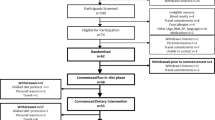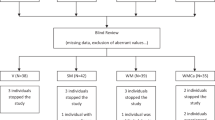Abstract
Objective: To examine, in free-living adults eating self-selected diets, the effects on plasma cholesterol of substituting saturated fat rich foods with either n-6 polyunsaturated or monounsaturated fat rich foods while at the same time adhering to a total fat intake of 30–33% of dietary energy.
Design: Two randomised crossover trials.
Setting: General community.
Subjects: Volunteer sample of healthy free-living nutrition students at the University of Otago. Trial I, n=29; and trial II, n=42.
Interventions: In trials I and II participants were asked to follow for 2½ weeks a diet high in saturated fat yet with a total fat content that conformed to nutrition recommendations (30–33% energy). During the 2 1/2 week comparison diet, saturated fat rich foods were replaced with foods rich in n-6 polyunsaturated fats (trial I) whereas in trial II the replacement foods were rich in monounsaturated fats. Participants were asked to maintain a total fat intake of 30–33% of energy on all diets.
Main outcome measures: Energy and nutrient intakes, plasma triglyceride fatty acids, and plasma cholesterol.
Results: When replacing saturated fat with either n-6 polyunsaturated fat or monounsaturated fat, total fat intakes decreased by 2.9% energy and 5.1% energy, respectively. Replacing saturated fat with n-6 polyunsaturated fat (trial I) lowered plasma total cholesterol by 19% [from 4.87 (0.88) to 3.94 (0.92) mmol/l, mean (s.d.)], low density lipoprotein cholesterol by 22% [from 2.87 (0.75) to 2.24 (0.67) mmol/l], and high density lipoprotein cholesterol by 14% [from 1.39 (0.36) to 1.19 (0.34) mmol/l], whereas replacing saturated fat with monounsaturated fat (trial II) decreased total cholesterol by 12%, low density lipoprotein cholesterol by 15%, and high density lipoprotein cholesterol by 4%, respectively. The change in the ratio of total to high density lipoprotein cholesterol was similar during trial I and trial II.
Conclusions: Young adults are very responsive to dietary-induced changes in plasma cholesterol even when an isocaloric replacement of saturated fat with n-6 polyunsaturated or monounsaturated fat is not achieved. Replacing saturated fat with either n-6 polyunsaturated or monounsaturated fat is equally efficacious at reducing the total to high density lipoprotein cholesterol ratio.
Sponsorship: University of Otago, Meadow Lea Ltd.
European Journal of Clinical Nutrition (2001) 55, 908–915
This is a preview of subscription content, access via your institution
Access options
Subscribe to this journal
Receive 12 print issues and online access
$259.00 per year
only $21.58 per issue
Buy this article
- Purchase on Springer Link
- Instant access to full article PDF
Prices may be subject to local taxes which are calculated during checkout
Similar content being viewed by others
References
American Dietetic Association (1981) Handbook Of Clinical Dietetics New Haven, CT: Yale University Press
Assmann G, Schriewer H, Schmitz G & Hagele E-O (1983) Quantification of high-density-lipoprotein cholesterol by precipitation with phosphotungstic acid/MgCl2 Clin. Chem. 29 2026–2030
Becker N, Illingworth DR, Alaupovic P, Conner WE & Sundberg EE (1983) Effects of saturated, monounsaturated, and ω-6 polyunsaturated fatty acids on plasma lipids, lipoproteins, and apoproteins in humans Am. J. Clin. Nutr. 37 355–360
Bligh EG & Dyer WJ (1959) A rapid method of total lipid extraction and purification Can. J. Biochem. Physiol. 37 911–917
Bonanome A & Grundy SM (1988) Effect of dietary stearic acid on plasma cholesterol and lipoprotein levels New Engl. J. Med. 318 1244–1248
Burlingham B, Milligan G, Apimerika D & Arthur J (1993) FOODfiles. Palmerston North New Zealand Institute for Crop and Food Research
Castelli WP, Abbott RD & McNamara PM (1983) Summary estimates of cholesterol used to predict coronary heart disease Circulation 67 730–734
Castelli WP, Garrison RJ, Wilson PWF, Abbott RD, Kalousdian S & Kannel WB (1986) Incidence of coronary heart disease and lipoprotein cholesterol levels: the Framingham Study J.A.M.A. 256 2835–2838
Clarke R, Frost C, Collins R, Appleby P & Peto R (1997) Dietary lipids and blood cholesterol: quantitative meta-analysis of metabolic ward studies Br. Med. J. 314 112–117
Connor WE & Connor SL (1997) Should a low-fat, high-carbohydrate diet be recommended for everyone? The case for a low-fat, high-carbohydrate diet. New Engl. J. Med. 337 562–563
Friedewald WT, Levy RI & Fredrickson DS (1972) Estimation of the concentration of low-density lipoprotein cholesterol in plasma, without the use of the preparative ultracentrifuge Clin. Chem. 18 499–502
Grundy SM & Denke MA (1990) Dietary influences on serum lipids and lipoproteins J. Lipid Res. 31 1149–1172
Gustafsson I, Vessby B & Nydahl M (1992) Effects of lipid-lowering diets enriched with monounsaturated and polyunsaturated fatty acids on serum lipoprotein composition in patients with hyperlipoproteinaemia Atherosclerosis 96 109–118
Hegsted DM, Ausman LM, Johnson JA & Dallal GE (1993) Dietary fat and serum lipids: an evaluation of the experimental data Am. J. Clin. Nutr. 57 875–883
Howard BV, Hannah JS, Heiser CC, Jablonski KA, Paidi MC, Alarif L, Robbins DC & Howard WJ (1995) Polyunsaturated fatty acids result in greater cholesterol lowering and less triacylglyerol elevation than do monounsaturated fatty acids in a dose–response comparison in a multiracial study group Am. J. Clin. Nutr. 62 392–402
Jacobs DR, Mebane IL, Bangdiwala SI, Criqui MH & Tyroler HA (1990) High density lipoprotein cholesterol as a predictor of cardiovascular disease mortality in men and women: the follow-up study of the lipid research clinics prevalence study Am. J. Epidemiol. 131 32–47
Katan MB, Grundy SM & Willett WCW (1997) Should a low-fat, high-carbohydrate diet be recommended for everyone? Beyond low fat diets New Engl. J. Med. 337 563–566
Keys A, Anderson JT & Grande F (1965) Serum cholesterol response to changes in the diet. IV. Particular saturated fatty acids in the diet. Metabolism 14 776–787
Kinosian B, Glick H & Garland G (1994) Cholesterol and coronary heart disease: predicting risks by levels and ratios Ann. Intern. Med. 121 641–647
Klag MJ, Ford DE, Mead LA, He J, Whelton PK, Liang K-Y & Levine DM (1993) Serum cholesterol in young men and subsequent cardiovascular disease New Engl. J. Med. 328 313–318
Leibel RL, Rosenbaum M & Hirsch J (1995) Changes in energy expenditure resulting from altered body weight New Engl. J. Med. 332 621–628
Lichtenstein AH, Ausman LM, Carrasco W, Jenner JL, Gualtieri LJ, Goldin BR, Ordovas JM & Schaefer EJ (1993) Effects of canola, corn, and olive oils on fasting and postprandial plasma lipoproteins in humans as part of a National Cholesterol Education Program Step 2 Diet Arterioscler. Thromb. 13 1533–1542
Mann J, Crooke M, Fear H, Hay D, Jackson R, Neutze J & White H (1993) Guidelines for the detection and management of dyslipidaemia N. Z. Med. J. 106 133–142
Marshall R (1996) Diet Entry and Storage/Diet Cruncher Dunedin, New Zealand
Mata P, Alvarez-Sala LA, Rubio MJ, Nuño J & De Oya M (1992) Effects of long-term monounsaturated- vs polyunsaturated-enriched diets on lipoproteins in healthy men and women Am. J. Clin. Nutr. 55 846–850
Mattson FH & Grundy SM (1985) Comparison of effects of dietary saturated, monounsaturated, and polyunsaturated fatty acids on plasma lipids and lipoproteins in man J. Lipid. Res. 26 194–202
Mensink RP & Katan MB (1987) Effect of monounsaturated fatty acids vs complex carbohydrates on high-density lipoproteins in healthy men and women Lancet i, (8525) 122–125
Mensink RP & Katan MB (1989) Effect of a diet enriched with monounsaturated or polyunsaturated fatty acids on levels of low-density and high-density lipoprotein cholesterol in healthy women and men New Engl. J. Med. 321 436–441
Mensink RP & Katan MB (1992) Effect of dietary fatty acids on serum lipids and lipoproteins—a meta-analysis of 27 trials Arterioscler. Thromb. 12 911–919
Miller N (1975) Plasma high-density-lipoprotein concentration and development of ischaemic heart disease Lancet i 16–19
Myers L, Coughlin SS, Webber LS, Srinivasan SR & Berenson GS (1995) Prediction of adult cardiovascular multifactorial risk status from childhood risk factor levels. The Bogalusa Heart Study. Am. J. Epidemiol. 142 918–924
NCEP (1991) Report of the expert panel on population strategies for blood cholesterol reduction: executive summary Arch. Intern. Med. 151 1071–1084
NCEP (1993) Summary of the second report of the National Cholesterol Education Program Expert Panel on Detection, Evaluation and Treatment of High Blood Cholesterol in Adults (Adult Treatment Panel II). J.A.M.A. 269 3015–3023
Noakes M & Clifton PM (1998) Oil blends containing partially hydrogenated or interesterified fats: differential effects on plasma lipids Am. J. Clin. Nutr. 68 242–247
O'Dea K, Traianedes K, Chisholm K, Leyden H & Sinclair A (1990) Cholesterol-lowering effect of a low-fat diet containing both lean beef is reversed by the addition of beef fat Am. J. Clin. Nutr. 52 491–494
Rosa JL, Hunninghake D, Bush D, Croqio M, Getz G & Gotto A (1990) The cholesterol facts. A summary of the evidence relating dietary fats, serum cholesterol, and coronary heart disease. A joint statement by the American Heart Association and the National Lung, and Blood Institute. The Task Force on Cholesterol Issues, American Heart Association. Circulation 81 1721–1733
Russell DG, Parnell WR, Wilson NC et al (1999) NZ Food: NZ People. Key results of the 1997 National Nutrition Survey Wellington: Ministry of Health
Vega GL, Groszek E, Wolf R & Grundy SM (1982) Influence of polyunsaturated fats on composition of plasma lipoproteins and apolipoproteins J. Lipid Res. 23 811–822
Wahrburg U, Martin H, Sandkamp M, Schulte H & Assmann G (1992) Comparative effects of a recommended lipid-lowering diet vs a diet rich in monounsaturated fatty acids on serum lipid profiles in healthy young adults Am. J. Clin. Nutr. 56 678–683
Wardlaw GM & Snook JT (1990) Effect of diets high in butter, corn oil, or high-oleic acid sunflower oil on serum lipids and apolipoproteins in men Am. J. Clin. Nutr. 51 815–821
Acknowledgements
The authors thank the participants for their enthusiasm and commitment, and Mrs Margaret Waldron for expert venipuncture and help with participants.
Author information
Authors and Affiliations
Corresponding author
Rights and permissions
About this article
Cite this article
Hodson, L., Skeaff, C. & Chisholm, WA. The effect of replacing dietary saturated fat with polyunsaturated or monounsaturated fat on plasma lipids in free-living young adults. Eur J Clin Nutr 55, 908–915 (2001). https://doi.org/10.1038/sj.ejcn.1601234
Received:
Revised:
Accepted:
Published:
Issue Date:
DOI: https://doi.org/10.1038/sj.ejcn.1601234
Keywords
This article is cited by
-
Centralized health management based on hot spring resort improves physical examination indicators and sleep quality in people at high risk of chronic diseases: a randomized controlled trial
International Journal of Biometeorology (2023)
-
Impact of Fatty Acids on Obesity-Associated Diseases and Radical Weight Reduction
Obesity Surgery (2022)
-
Saturated and monounsaturated fatty acids in membranes are determined by the gene expression of their metabolizing enzymes SCD1 and ELOVL6 regulated by the intake of dietary fat
European Journal of Nutrition (2020)
-
Effect of supplementation with flaxseed oil and different doses of fish oil for 2 weeks on plasma phosphatidylcholine fatty acids in young women
European Journal of Clinical Nutrition (2018)
-
A randomized controlled trial of the effects of a prudent diet on cardiovascular risk factors, gene expression, and DNA methylation - the Diet and Genetic Intervention (DIGEST) Pilot study
BMC Nutrition (2016)



